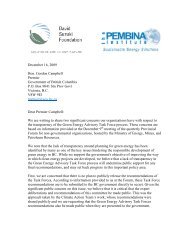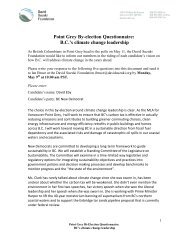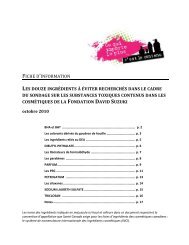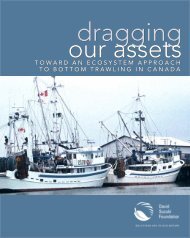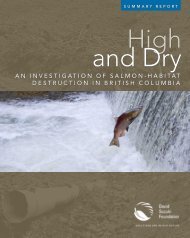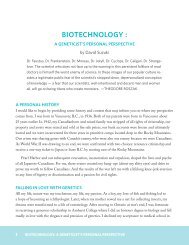Finding Solutions — Spring 2012 (PDF) - David Suzuki Foundation
Finding Solutions — Spring 2012 (PDF) - David Suzuki Foundation
Finding Solutions — Spring 2012 (PDF) - David Suzuki Foundation
Create successful ePaper yourself
Turn your PDF publications into a flip-book with our unique Google optimized e-Paper software.
eal life<br />
Each Canadian province has a HHW collection program to<br />
help you dispose of these chemicals with minimal environmental<br />
impact. Search your city website for drop-off depots and collection<br />
dates.<br />
Before heading to the depot<br />
• Keep materials in their original containers or ensure that<br />
containers are well-labelled<br />
How to dispose of household<br />
hazardous waste<br />
Household hazardous waste (HHW) can cause illness or death to<br />
people, plants, and animals. It can contaminate our bodies, homes,<br />
and the environment.<br />
HHW includes hair colouring, car wax, nail polish remover,<br />
rechargeable batteries, and shoe polish. Most household cleaners<br />
are also HHW, including abrasive and all-purpose cleaners,<br />
aerosol air fresheners, bleach, disinfectants, drain cleaners, fabric<br />
softeners, and glass and toilet cleaners.<br />
If you have these chemicals in your home, you’ll want to dispose<br />
of them correctly. This will ensure waste workers are not at risk of<br />
inhaling toxic substances and reduce the chance of fires or explosions.<br />
Never pour or flush HHW down the drain. Not only will this<br />
contaminate our waterways and oceans, it can corrode plumbing<br />
and cause septic system failure.<br />
• Do not mix different products together<br />
• Tightly cap all containers<br />
You can identify HHW by these hazard symbols<br />
Toxic: can cause illness<br />
Corrosive: can eat through materials or living tissue<br />
Flammable: can catch fire or burn easily<br />
Reactive/explosive: can cause rapid heating<br />
or explosions<br />
Lindsay Coulter<br />
<strong>David</strong> <strong>Suzuki</strong>’s Queen of Green<br />
funding solutions<br />
Turn e-waste into donation dollars<br />
Clean out your desk drawers and closets! Keep old, obsolete,<br />
or unwanted electronics out of landfills and fundraise for the<br />
<strong>Foundation</strong> by sending them to Think Recycle.<br />
It’s easy. Collect at least 10 acceptable electronics (e.g., cellphones,<br />
print cartridges, digital cameras, laptops, and iPods). Then register<br />
at www.thinkrecycle.com (say you’re raising funds for the <strong>David</strong><br />
<strong>Suzuki</strong> <strong>Foundation</strong>) and follow their directions for getting your<br />
discards to their plant.<br />
Reusable electronics will be refurbished. Those that can’t be<br />
brought back to life will be carefully dismantled and separated,<br />
and metals, glass, and plastic turned into raw materials for future<br />
production of new goods.<br />
Organize an e-waste drive at your office or school. Think Recycle<br />
even plants a tree for every 24 qualifying products donated!<br />
Gail Mainster<br />
Kimberly Hoover of Think Recycle with <strong>David</strong> <strong>Suzuki</strong><br />
Secondary School students Jasmine Kaur, Zoya Chahal,<br />
Mannal Maqbol, Nikki Sandhu, and Nikeshia Hamilton.<br />
6



